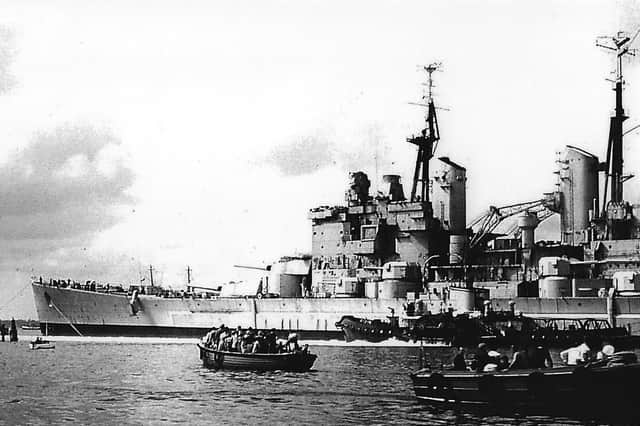HMS Vanguard, the ship they couldn't tame | Nostalgia


It would appear that the ship was taken by the turning tide but there is far more to the story.
I was glad to make the acquaintance of Alan Neal who was the helmsman of the Advice, one of thesea-going tugs that was to manoeuvre Vanguard to Scotland along with three others.
Advertisement
Hide AdAdvertisement
Hide AdAlan was born in 1939 and moved to the early Leigh Park estate in 1949. ‘Hursley Road, where we lived, was surrounded by fields back then,’ he tells me.


When he was 14, Alan attended the Portishead Sea School where he remained for two years. The boys were then either sent to the Royal Navy or the Merchant Navy, no ifs, buts or maybes.
From the school he went to Avonmouth where the Shipping Federation had its offices. That was where seamen could obtain work on a ship.
Alan was offered a ship by the clerk behind the counter but a worldly seaman whispered that Alan should not take it as it was what was known as a London-Greek tramp steamer. Anyway, Alan took the position as a deck boy and began his nine years at sea.
Advertisement
Hide AdAdvertisement
Hide AdIn his time he travelled around the world twice passing through the Panama Canal east to west and west to east.


He served on many ships even a short time on the Queen Elizabeth but because of his attitude was put ashore.
Returning to Havant a pal told him there was a vacancy on a deep sea tug so Alan inquired and obtained the vacancy. The tug was the RFA Advice.
One would think that a tugboat would have two or three crew members but Alan tells me there was the captain, bosun, bosun’s mate, first officer and second officer plus six men on watch. There was also the cook, making a dozen men in all. They worked four hours on, eight off with two hours at the wheel.
Advertisement
Hide AdAdvertisement
Hide AdOn August 4, 1960, the redundant battleship HMS Vanguard was to be towed from Portsmouth Dockyard to Faslane in Scotland to be broken up.
Alan says the plan was for the dockyard tugs to tow Vanguard through the harbour to a point opposite the Still and West pub where the sea-going tugs would take over. As we know, Vanguard went adrift somewhere between the changeover of towing hawsers and she landed bows-on into Point. From that time to this there appears to be a dispute about who was to blame.
Alan told me Advice was secured to Vanguard’s port side and as she veered off course the captain of Advice was going mad as he tried to push the battleship away from Point... except the two dockyard tugs on the starboard side hindered him from doing so. Advice’s captain could see what was going to happen but could do nothing, even with the great amount of power the tug was capable of producing. So Vanguard came to a stop.
Alan believes to this day that Vanguard did not become stranded in the mud but just settled some feet from spectators who were waving at the battleship’s skeleton crew who were in fact screaming back at them to run for their lives.
Advertisement
Hide AdAdvertisement
Hide AdEventually matters were sorted. The three sea-going tugs were secured to Vanguard and with another astern they made their way into the Solent, went around the back of the Isle of Wight heading for Cornwall and then turned north for Scotland. But this was not the end of Vanguard’s adventures for she tried to make another escape from the breakers.
In the Irish Sea between Northern Ireland and the Isle of Man the order came through that the middle tug of the three, Advice, would be released from Vanguard so she could drop astern of her.
Somehow the signal was misread, misheard or ignored and Vanguard’s skeleton crew released all three towing cables and with no tug attached to her stern Vanguard was adrift again.
A tow hawser is not one long cable with 100ft between the two vessels but can be a mile in length stretching in a deep ‘U’ under the sea. It took the tugs nearly an hour to draw in their cables before they could all make their way as fast as a tug can to catch Vanguard now two miles in the distance.
Advertisement
Hide AdAdvertisement
Hide AdEventually Vanguard was captured and made her sad way to the breakers.
Alan says that at Faslane there were dozens of naval ships awaiting their fate. ‘There were destroyers, frigates and cruisers all rusting away. It was, to a seaman, a most sad sight and something I will never forget. These once proud ships now among a fleet of rusting decaying wrecks waiting to be turned into razor blades as we used to say.’
Alan left the sea when he was just 26 claiming it had become a young man’s game.
A message from the editor, Mark Waldron.
You can subscribe here for unlimited access to our online coverage, including Pompey, for 27p a day.
Comment Guidelines
National World encourages reader discussion on our stories. User feedback, insights and back-and-forth exchanges add a rich layer of context to reporting. Please review our Community Guidelines before commenting.